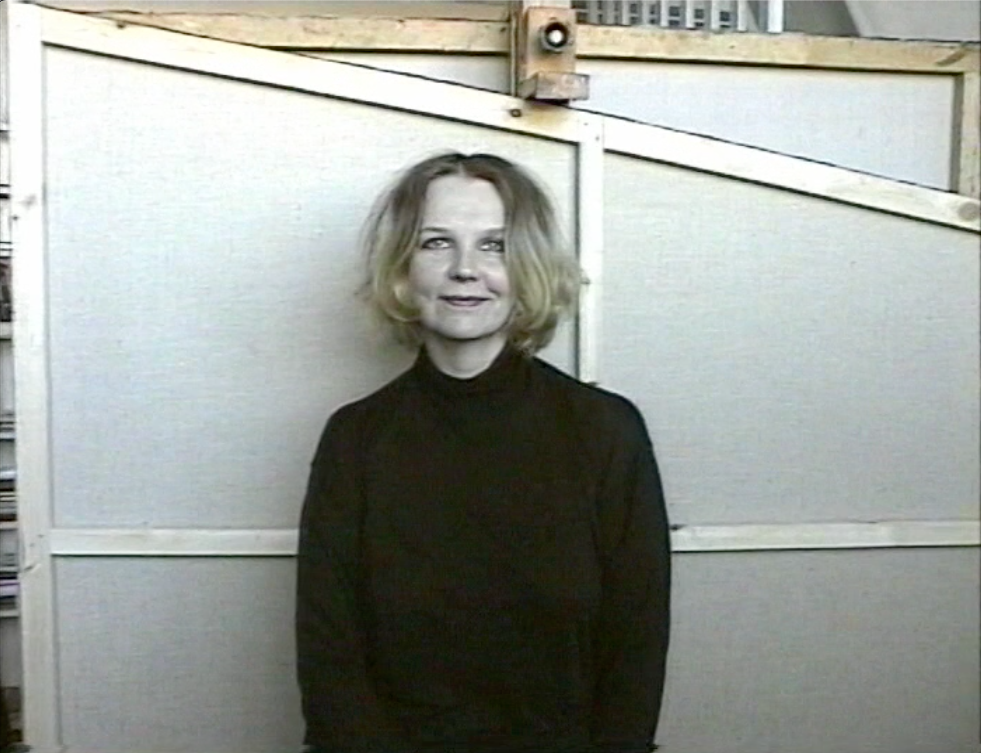
Kai Kaljo is primarily known as a video artist, although her work also includes painting, photography, fresco, stained glass, and installation art. Kaljo’s themes are inspired by her personal and everyday life extending into existential and social statements. Using black humour and irony, she often questions power relations in the art world, whether they are based on gender (male artists vs female artists), choice of artistic media (traditional art vs new media), geography (Estonia and Eastern Europe vs the international Western art world) or economic status (the precarity of freelance artists).
In the 1980s, Kaljo studied monumental painting, and in the 1990s she found herself in a new society, where state art commissions had suddenly disappeared and the art field of newly independent Estonia saw the emergence of new media. Her first notable moment of recognition came in 1994 with her site specific installation “Genesis and Disappearance of Life” at the 2nd Annual Exhibition of the Soros Center of Contemporary Arts, Estonia “Unexistent Art”.
Kaljo became known internationally in 1997 when she presented her first video “Loser” at the exhibition “Funny versus Bizarre” at the Contemporary Art Centre, Vilnius. The work was soon exhibited at other international shows as well. In the video, using laconic irony, Kaljo describes her lived reality as an Estonian woman artist – so far from the success stories heralded as part of the official cultural politics. She has addressed the precarious situation of artists in her later work, for example, in the photo installation “The more I work the poorer I am” (2006), depicting scenes from the artist’s work days during which she makes a loss of € 246.
The art historian Mari Laanemets has described Kai Kaljo’s work as “a sceptical meditation bordering on self-deprecation”. In the video “I am no Adamson-Eric” (2018) she plays with the idea of who is allowed to participate in the community of art (history). Kaljo tells the story of a conversation she had with her mother: when she was younger, she asked her mother, why she could not become an artist as multifaceted as the famous Estonian artist Adamson-Eric. Her mother snapped back at her: “But you are no Adamson-Eric!” In the video “Even the name is sometimes the same” (2017), also shown in Paris and Berlin at the Rencontres Internationales festival, Kaljo contemplates the randomness of human life, as she searches for figures who often remain in the background in historic photographs.
“The public flatness and hidden beauty of life seem to step in front of Kai Kaljo’s camera lens all on their own accord,” writes Mari Laanemets. Often her spontaneous works seem to almost randomly capture a moment, for example, in “Silent Nation” (2009) or “I am looking at nature and nature is looking at me” (2008). The photo series “Invisible” (2019) depicts the view from the window of the Mazzano Romano residency, using the laconic image to conclude the artist’s experience of the residency. Aesthetically, Kaljo frequently uses the means of expression of DIY art, like hand-held cameras, filming computer screens, narrating the works herself, semi-random photographs. This seemingly random approach to filming creates a distinct contrast to the sharpness and ironic attitude of the art works.
In several works, Kaljo has used stories of herself or her family. For example, “Domestic Violence” (2001) is based on a tense conversation with her ex-partner, who is tied to a bed. “My Father’s Letters” (2014, Tartu Art Museum) is a captivating homage to her artist father, but at the same time it also includes an ironic and detached view on the subject matter. Kai Kaljo’s exhibition “Flowers” (2018) is also based on the artist’s family history – it is a reference to the artist’s grandmother, whose work as the decorator of tin wreaths was exhausting. At the time, her grandmother was not considered an artist. By painting flowers Kaljo also points out the suffocating attitude in the discourse of contemporary art, which does not take flower painting seriously, or only considers it suitable for women artists.
Kai Kaljo graduated from the painting department of the Estonian Academy of Arts (1990) and has since had solo exhibitions in Estonia as well as elsewhere in Europe. Kaljo has also participated in group exhibitions and film and video festivals all over the world. Her works belong to the collections of Moderna Museet, the Art Museum of Estonia and Sprengel Museum, among others. She has been awarded the Kristjan Raud Prize (2006), the Annual Award of Estonian Cultural Endowment (2000,) and the Award of the Annual Exhibition of the Soros Center for Contemporary Arts, Estonia (1994, 1998).